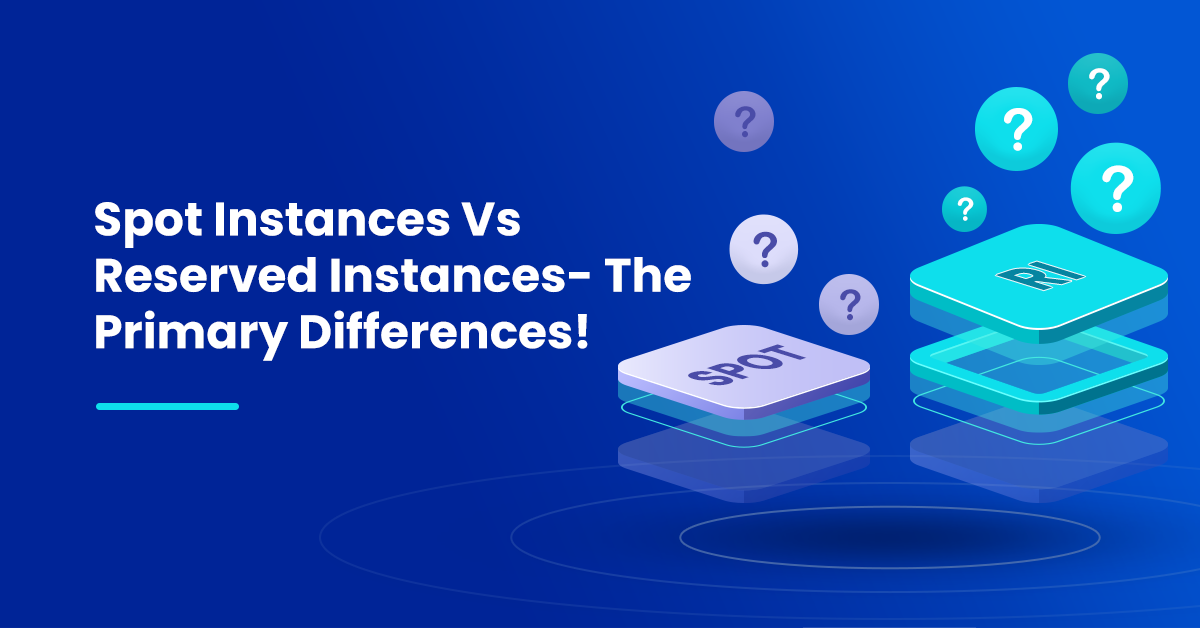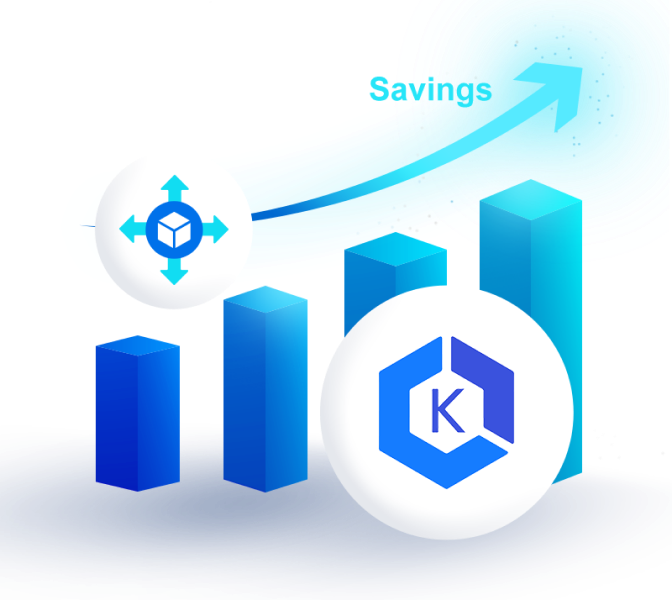Spot Instances vs Reserved Instances: What to Choose?
What Are Spot Instances?
Spot Instances involve bidding on excess or unused capacity available with AWS, and paying only for the compute you use. While Spot Instance prices fluctuate based on the supply and demand of the current market, the prices are usually less than On-Demand and Reserved Instances. With Spot, you can get up to 90% off with no required long-term commitment. However, there is a catch: AWS can terminate Spot instances at any time a 2-minute notice period. This happens when the capacity demand increases or your bid for the Spot instance gets outbid. When AWS wants to reclaim a Spot Instance, it will send a two-minute warning through CloudWatch Events and instance metadata. You can use these two minutes to save the application state, upload log files, or drain any presently running containers. Spot Instances are often suitable for workloads that are fault-tolerant, stateless, non-critical, and/or flexible since these instances can get interrupted easily without much notice. Some examples include batch processing, testing, or development.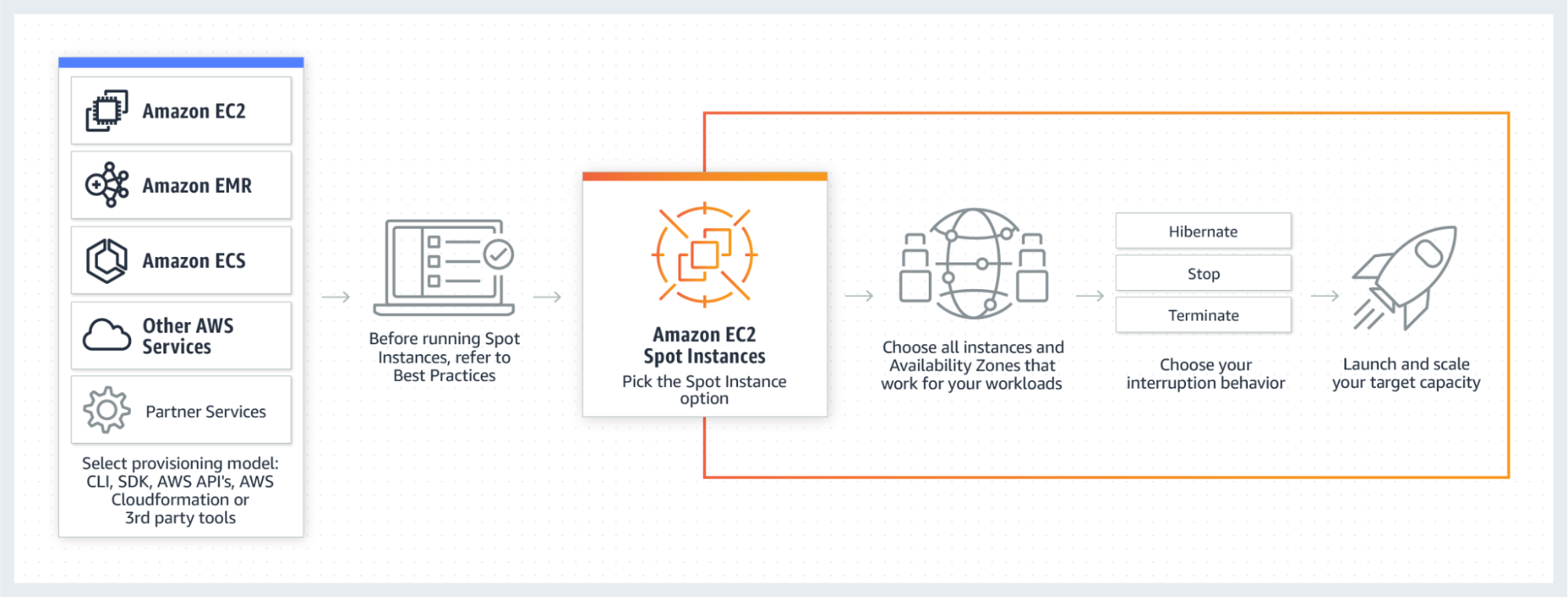 Source: AWS
Source: AWS
Advantages And Disadvantages of Spot Instances
Advantages
- Massive cost savings: Spot Instances are typically 70–90% cheaper than On-Demand instances, making them ideal for cost-sensitive workloads like batch processing, containerized jobs, and data analysis.
- Scale compute capacity affordably: You can run large-scale workloads (e.g., distributed training, high-throughput simulations) at a fraction of the cost, enabling experimentation or parallelism that would be too expensive otherwise.
- Same performance as On-Demand: Spot Instances use the same underlying hardware and offer identical performance, networking, and storage options.
- Seamless integration with autoscaling: You can mix Spot and On-Demand Instances in Auto Scaling Groups, helping reduce costs while maintaining baseline reliability.
Disadvantages
- Interruptions: AWS can terminate Spot Instances with just a 2-minute warning when capacity is no longer available at your bid price. This makes them unsuitable for critical or stateful workloads without fault tolerance.
- Unpredictable availability: Spot capacity fluctuates based on regional demand. There’s no guarantee your preferred instance type will always be available at the Spot price.
- Can lead to double-paying: If you have unused Reserved Instances or Savings Plans, running workloads on Spot can waste those prepaid commitments.
- Limited support for some services: Not all AWS services support Spot Instances (e.g., managed RDS, Lambda, or certain GPU workloads in Bedrock or SageMaker).
What Are Reserved Instances?
Reserved Instances allow you to reserve a specific amount of computing capacity for a fixed time period, which is usually one or three years. Since you commit to a long-time contract, you can get up to 72% discount on monthly or hourly rates, as compared to On-Demand. When Reserved Instances are assigned to a particular availability zone, they reserve the capacity for that zone only. Reserving the capacity means you can launch the instances whenever required. If you are committing to a RI for one or three years, make sure that you will be utilizing its complete capacity for the entire period of time to optimize cloud costs. Reserved Instances are more suitable for workloads with a steady and predictable demand, like databases and web servers.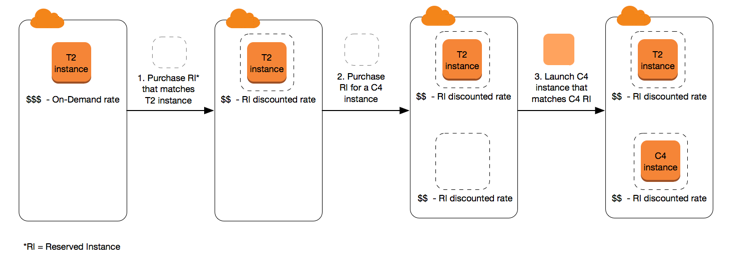 Source: AWS
There are two types of Reserved Instances available:
Standard RIs: They are usually used in workloads that have little to no variation in performance over the period of several months or years. With standard RIs, you can modify the scope, availability zone, instance size, and networking type of the reserved instances. You can also sell them on the Reserved Instance Marketplace in some cases.
Convertible RIs: They are used for workloads that require flexibility in terms of changing operating systems or instance families. Note that you cannot sell them in the Reserved Instance Marketplace.
Source: AWS
There are two types of Reserved Instances available:
Standard RIs: They are usually used in workloads that have little to no variation in performance over the period of several months or years. With standard RIs, you can modify the scope, availability zone, instance size, and networking type of the reserved instances. You can also sell them on the Reserved Instance Marketplace in some cases.
Convertible RIs: They are used for workloads that require flexibility in terms of changing operating systems or instance families. Note that you cannot sell them in the Reserved Instance Marketplace.
Advantages And Disadvantages of Reserved Instances
Advantages
- Significant cost savings: Standard RIs offer up to 72% off compared to On-Demand pricing, and Convertible RIs offer up to 55%, making them ideal for steady-state workloads.
- Predictable billing: RIs provide consistent hourly billing, which simplifies budgeting and long-term forecasting.
- Convertible RIs can be exchanged: Convertible RIs allow you to change instance families, OS types, or tenancies during the term, so you’re not locked into your original configuration (for a slightly lower discount).
- Standard RIs can be resold: If your usage changes, you can often resell unused Standard RIs in the RI Marketplace — unless they were purchased through an EDP or special discount.
Disadvantages
- Commitment risk: You’re locked into a 1- or 3-year term. If your usage drops or changes, you may end up paying for unused capacity.
- Lack of real-time flexibility: Unlike On-Demand or Spot, RIs can’t adapt dynamically to changes in traffic, infrastructure design, or new instance types.
- Complexity: There are literally thousands of types of RI — without careful planning, you can overcommit or choose the wrong type, leading to wasted spend.
- Management overhead: Tracking utilization, managing expirations, and optimizing coverage across accounts and services can be time-consuming without the right tooling.
The Ultimate Guide to AWS Commitments
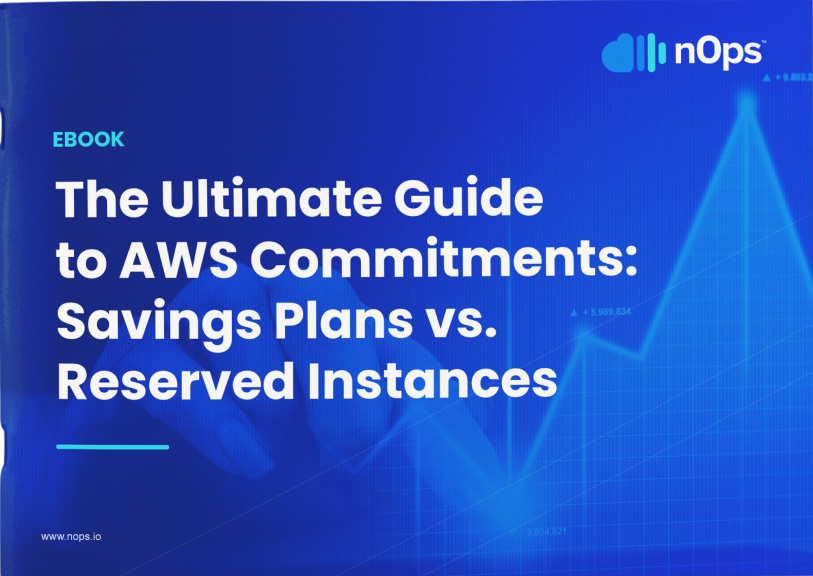
Difference Between Spot Instances vs Reserved Instances
| Feature | Spot Instances | Reserved Instances |
| Pricing model | Prices vary based on the current supply and demand of the Spot market | Prices are fixed for one-year or three-year commitment |
| Discounts | Prices are up to 90% less than On-Demand instances | Prices up to 72% less than On-Demand instances |
| Availability of instances | Availability varies and depends on the Spot market | Available all the time since capacity is reserved |
| Risk of interruption | Instances can get interrupted with two minutes of notice | No interruption risks |
| Flexibility | Highly flexible with no long-term commitment | Decreased flexibility due to commitments for one or three years |
| Ideal for | Flexible, fault-tolerant and noncritical workloads | Predicticable workloads |
Spot Instances vs Reserved Instances: How to Choose the Right EC2 Pricing Model?
When deciding between Spot Instances and Reserved Instances (RIs), consider these five dimensions impacting cost efficiency, operational reliability, and infrastructure strategy.
1. Budget Consideration
Spot Instances offer steep discounts — great for cutting costs on interruptible workloads or handling intermittent usage spikes (e.g., nightly batch jobs, bursty dev/test environments). RIs are better for predictable, steady-state workloads where you know you’ll need capacity 24/7. But upfront cost isn’t the only consideration:
- Spot may save money on compute, but costs engineer time — handling interruptions, diversifying capacity pools, and tuning autoscaling logic.
- RIs save time with predictable behavior — but they’re “always on” whether you use the compute or not.
- You can’t “turn off” an RI — unused hours are wasted. You can shut down Spot to avoid cost.
- If you’ve already bought RIs or Savings Plans and use Spot instead, you risk double paying — unused commitments plus active Spot spend.
2. Workload Attributes
Spot works well for jobs that are fault-tolerant, parallelizable, or transient — like EMR, Spark, containerized ML training, or infrastructure experiments.
Reserved Instances are a better fit for workloads that need guaranteed continuity: production services, persistent databases, and monolithic applications that don’t tolerate interruption.
Key distinction: Spot is an operational fit, not just a financial one — it only works if your workload is architected to restart, resume, or tolerate gaps.
3. Interruption Risk and Engineering Resilience
Spot Instances can be reclaimed at any time with just 2 minutes’ notice. That risk isn’t theoretical — in high-demand periods or narrow capacity pools, interruptions are frequent and unpredictable.This can cause real problems:- Job failures or data loss if workloads don’t checkpoint or save intermediate state.
- Pipeline instability in systems like Spark or Airflow, especially when preempted in the middle of a DAG.
- Scaling delays when autoscalers can’t replace capacity fast enough, leading to queue buildup or latency.
- Increased engineering overhead from writing interruption handlers, diversifying across instance types, and tuning retry logic.
4. Control, Flexibility, and Lock-In
Spot gives you tactical flexibility — start and stop whenever you want, across a wide range of instance types. You’re not locked in; you can turn off Spot instances any time.
RIs offer financial efficiency if you know what you need — but they’re locked to instance families and regions (unless you use Convertible RIs, which can be difficult to manage without an automation platform).
Another mechanism adding flexibility is the Standard RI marketplace — but it’s worth noting that you can only resell RIs under certain circumstances and any RI purchased under a discount like EDP cannot be resold. Additionally, AWS has tightened policies around third-party resellers, limiting resale flexibility and making the process more restrictive than in previous years.
5. Layering Spot and Reserved Requires Orchestration Discipline
For the most flexibility and discounts, you’ll likely need a combination of both Spot and Reserved Instances. Many teams combine RIs for baseline workloads and Spot for burst capacity — a best practice in theory, but harder in execution. Without precise orchestration, you risk inefficiencies like:- Double paying: Spot instances running while Reserved capacity sits idle.
- Inefficient placement: Workloads landing on higher-cost On-Demand or incorrectly matched instances.
- Coverage waste: Reserved Instances applied to workloads that are scaled down or relocated.
- Optimize your RI, SP and Spot automatically for 50%+ savings — Copilot analyzes your organizational usage and market pricing to ensure you’re always on the best options.
- Reliably run business-critical workloads on Spot. Our ML model predicts Spot terminations 60 minutes in advance.
- Maximize flexibility with Convertible RIs — even if you’re not on Spot, nOps can optimize your RI and SP to maximize both savings and flexibility.
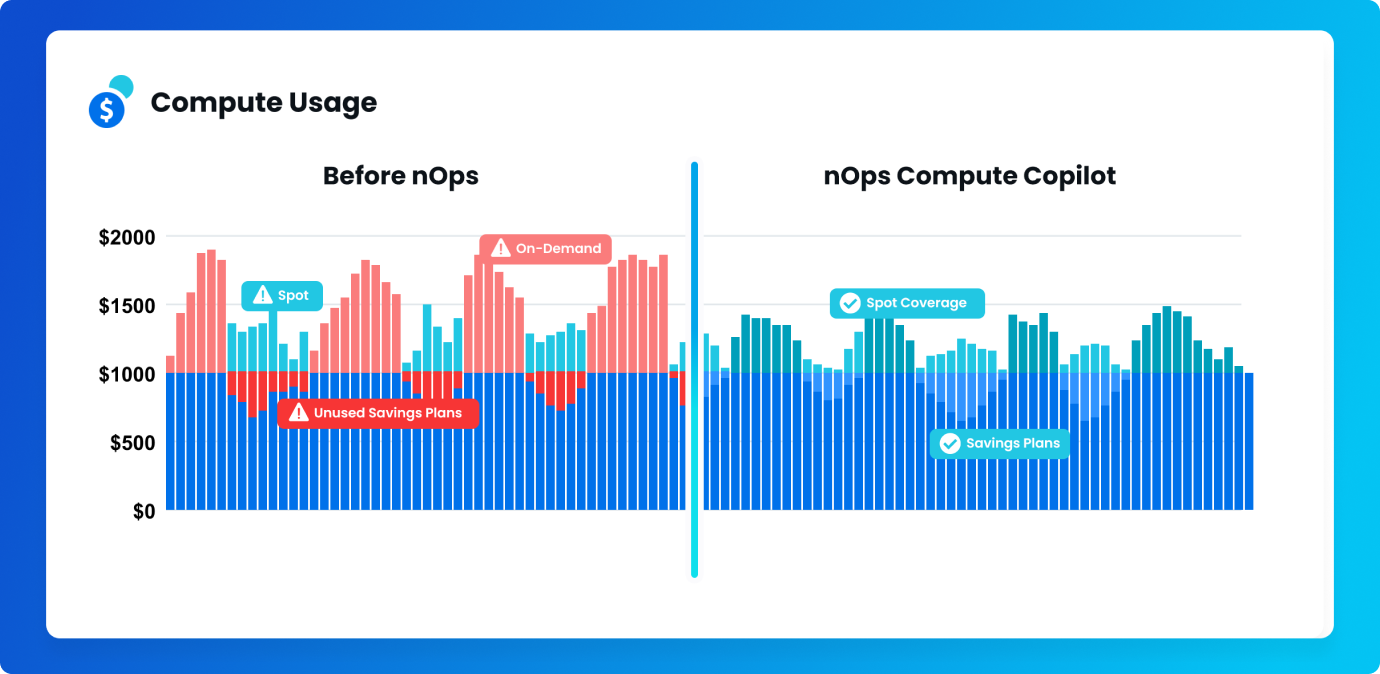
Frequently Asked Questions (FAQ)
Here are some commonly asked questions about EC2 Reserved Instances and Spot Instances.When should you use an EC2 Spot Instance?
Use EC2 Spot Instances when your workloads are fault-tolerant and can handle interruptions. Ideal use cases include batch processing, big data analysis, machine learning training, CI/CD pipelines, and stateless web servers. Spot Instances offer up to 90% cost savings compared to On-Demand pricing but can be reclaimed by AWS with only a two-minute warning. They’re best for scaling fleets cheaply where interruptions don’t significantly impact business operations. Tools like nOps make it much easier to automate Spot usage safely, handling interruptions, fallback, and scaling without manual engineering effort.
How long do EC2 Spot Instances last?
There is no guaranteed lifespan for EC2 Spot Instances. They run as long as AWS has available unused capacity. Most Spot Instances last for hours or days, but they can be interrupted at any time. AWS sends a two-minute interruption notice when capacity is reclaimed. Some AWS services, like Spot Fleet and EC2 Auto Scaling, can automatically replace interrupted instances.
Can Spot Instances be terminated?
Yes, AWS can terminate Spot Instances at any time if the demand for On-Demand capacity increases. You typically receive a two-minute warning before termination. You are not billed for partial hours if AWS terminates the instance (billing rounds down to the nearest second). However, if you terminate a Spot Instance yourself, you are billed for the entire instance-hour. Designing applications to handle sudden termination is essential when using Spot Instances.
Does Azure have Reserved Instances?
Yes, Azure offers Reserved Virtual Machine Instances, which are similar to AWS Reserved Instances. You can reserve VM instances for 1-year or 3-year terms and receive significant discounts compared to pay-as-you-go prices — often around 40–70% depending on the VM type and term length. Azure RIs are flexible: you can exchange them for different VM sizes within the same family or cancel for a small fee. However, they require upfront commitment to specific VM types and regions, making them best suited for predictable, long-term workloads that rarely change.



